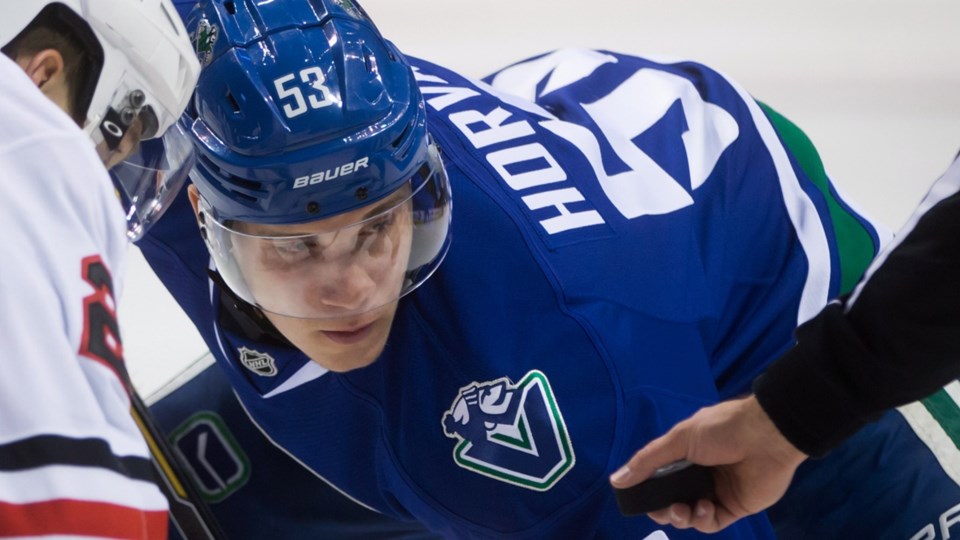19 months ago, Canucks Army blogger and noted prospect curmudgeon Rhys Jessop infamously wrote an article about what we could reasonably expect from Bo Horvat. His conclusion? Horvat was unlikely to become a top-six forward, would most likely top out as a very good third-line centre, and wouldn’t reach those modest heights for another 3-4 years.
Less than two years later, Horvat is about to start the season as the Canucks’ second-line centre. The 20-year-old gave the Canucks no choice with his pre-season performance, as he was frequently the best Canuck on the ice, finishing with 4 goals in 5 games.
At this point, any reasonable expectations have been blown out of the water, so how about some completely unreasonable ones?
Even Rhys has drastically changed his tune on Horvat, abandoning all pretenses of cynicism:
"Bo Horvat could be Ryan Johansen" is a whisper that's been floating in my head since the playoffs. It's becoming a loud scream.
— Rhys Jessop (@Thats_Offside) October 2, 2015
Now, this may seem like Rhys going from one extreme to the other, when expectations for Horvat should, perhaps, be a bit more modest, but the crazy thing is that the comparison isn’t actually crazy.
Johansen and Horvat are remarkably similar. Both were selected early in the first round when draft rankings had them as late round picks: International Scouting Services had Johansen ranked 17th overall heading into the 2010 draft and Horvat 24th overall in 2013.
It’s easy to understand why Johansen and Horvat weren’t consensus top-10 picks. Neither player scored at a point-per-game pace in Junior in their draft year, though Johansen came closest, putting up 69 points in 71 games, while Horvat scored 60 points in 67 games. Both turned it on in the playoffs, however, with Horvat tallying 16 goals and 23 points in 21 games and Johansen, 18 points in 13 games.
Looking directly at their point-per-game scoring closely illustrates their similarities. In their draft years, Johansen’s points-per-game was 0.97, while Horvat’s was 0.91. The following year, still in Junior, Johansen’s was 1.46, Horvat’s 1.37.
They both made the jump to the NHL at 19: Johansen scored 0.31 points per game, while Horvat scored 0.37.
Johansen faltered in his sophomore year, putting up just 12 points in 40 games in the lockout-shortened 2012-13 season, but his last two seasons have been outstanding, establishing him as a top-tier first-line centre. His 71 points last season were good for 16th in the NHL.
He shows no signs of slowing down, either, leading all players in the pre-season with a whopping 12 points in just 4 games. Sure, the pre-season doesn’t really matter, but, generally speaking, no one puts up Gretzky numbers in the pre-season either.
Johansen’s performance in the NHL marks him as a massive outlier: players who fall short of a point-per-game in the CHL in their draft years don’t generally turn into first line forwards. Of the six centres ahead of Johansen in scoring last season who came out of the CHL, all but one of them had 100+ point seasons in their draft year.
(The one exception: Tyler Johnson, who had just 35 points in 69 games in the WHL, because nothing about that guy makes any sense.)
Can Horvat be an outlier like Johansen? Can he become not just a first-line centre down the road but an elite first-line centre? Is he the heir apparent for Henrik Sedin that Canucks fans have been hoping for?
A few weeks ago I wrote about tempering expectations when it comes to Horvat and that’s still sound advice. Even Johansen suffered through a sophomore slump, so, on the one hand, it’s a good idea to keep the bar low.
On the other hand, screw that. Hockey is meant to be fun. It’s fun to look at the best young player on the team and expect the unreasonable. So go ahead: get crazy. Predict a 30-goal season. Expect 60 -- no, 70 points. Dream about teams having to gameplan how to shutdown Horvat, leaving the Sedins to feast on second-pairing defencemen. Imagine the Sedins on the second line by the end of the season.
Go for it.



